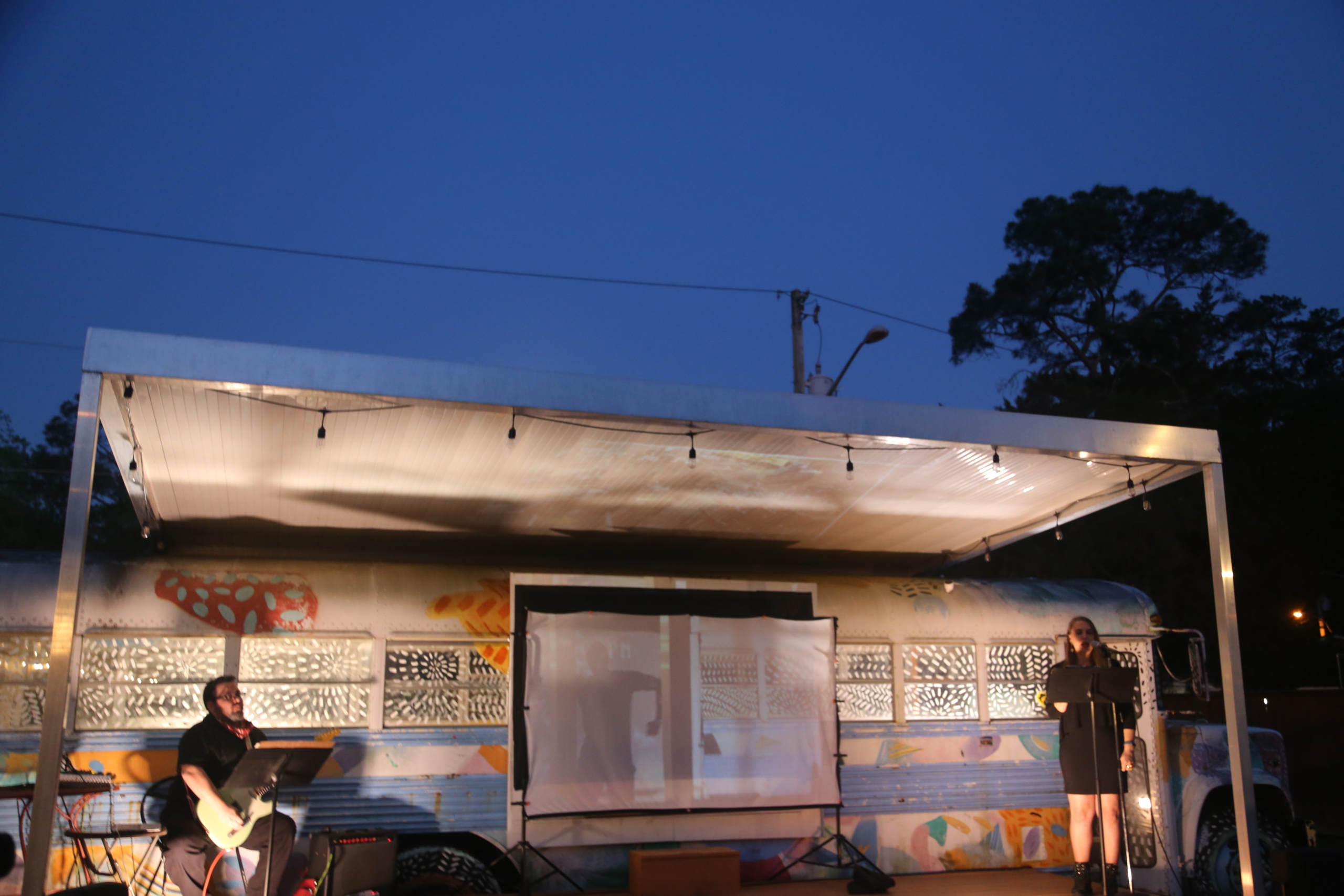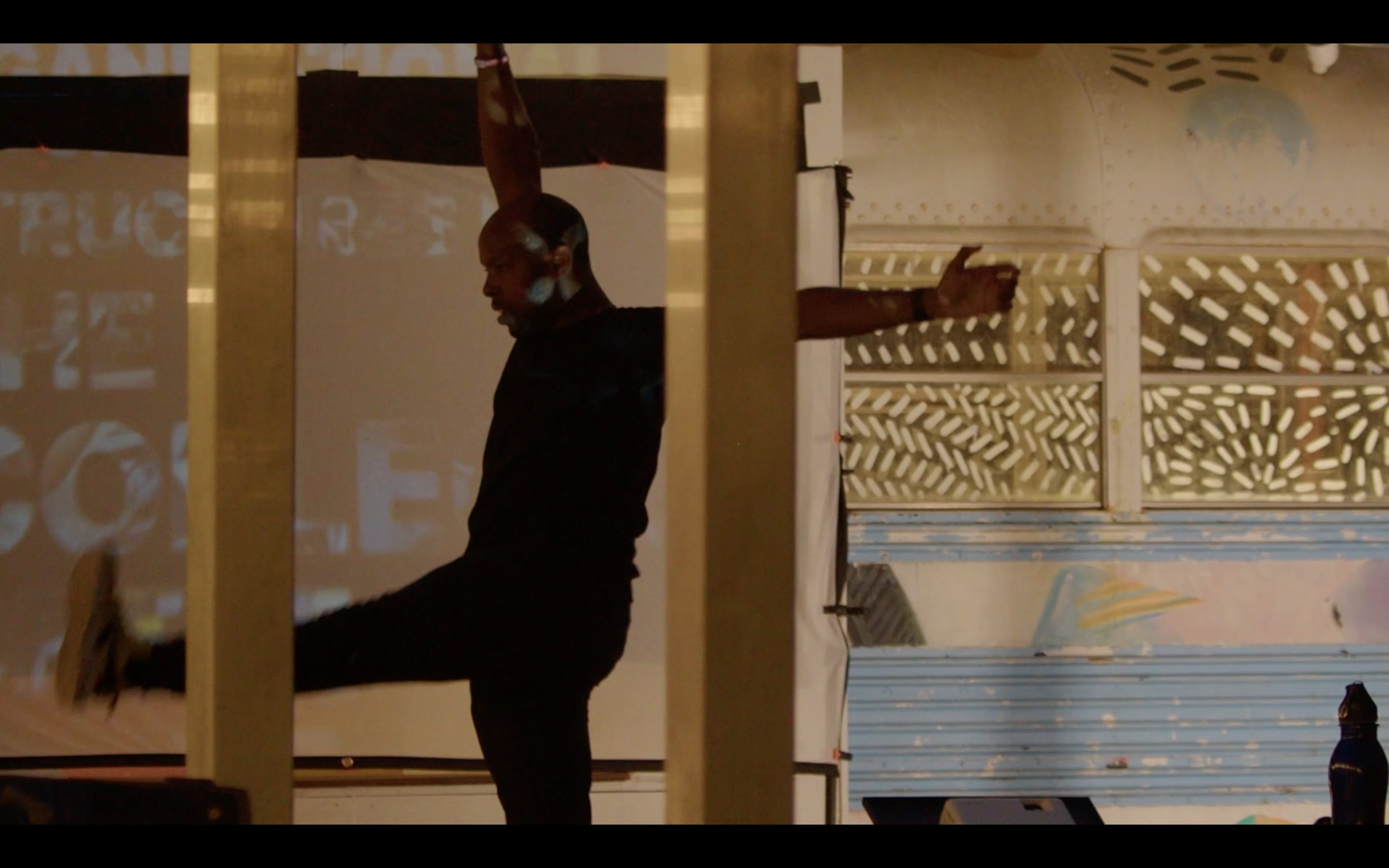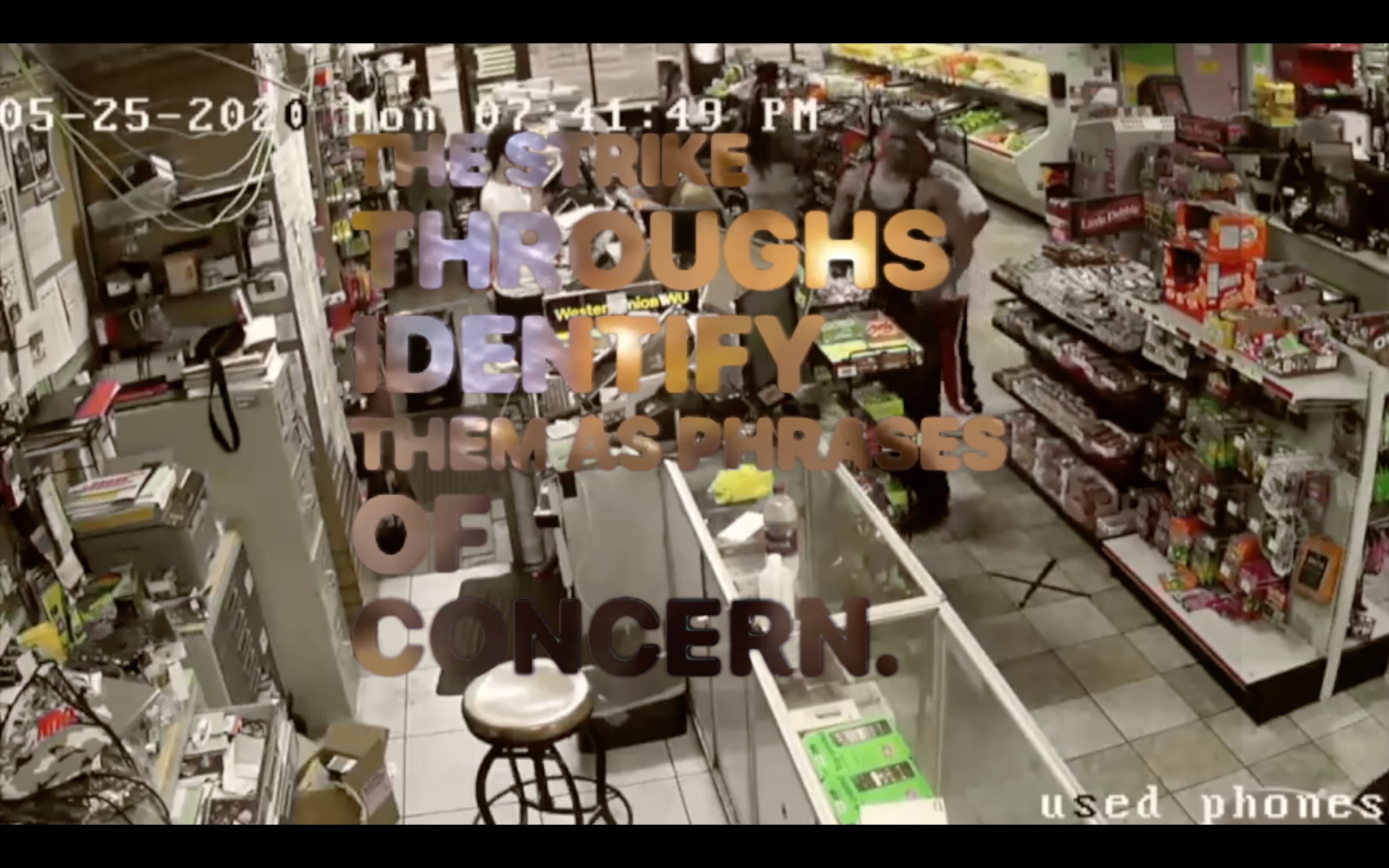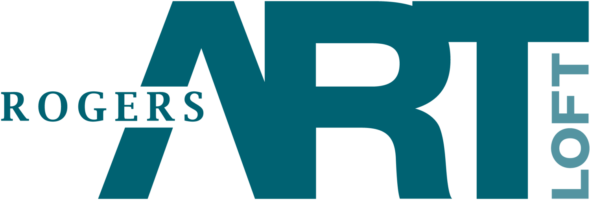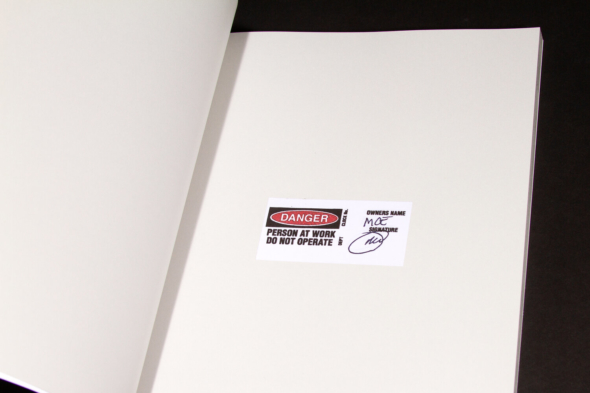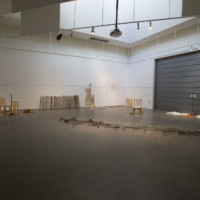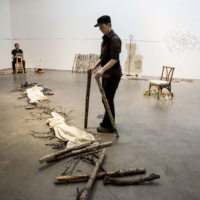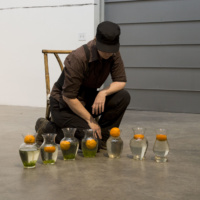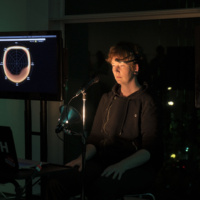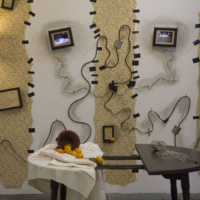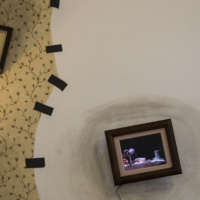performance
Sun Suite (10,000 Years of Peace) (2024)

A workshop performance with reflected sunlight. Raymond Oppenheimer built a series of motors to control light-reflective mirrors. I collaborated with a creative team to explore, program and work with these mirrors in response to Baron Tymas’ piece “10,000 Years of Peace” from his Snow Suite. Performer/Creator Camille Huang improvised with and tested the capacities of the reflected light and movement of the mirrors over a series of rehearsals both indoors with reflected stage light and outdoors in the afternoon sun.
Artistic Director/Producer: Meghan Moe Beitiks
Composer: Baron Tymas
Performer/Creator: Camille Huang
Technical Engineer: Ray Oppenheimer
Board Operator: Kris Hodder
Technical and Moral Support: Pietro Cerone, Christine White
Documentation: Brooklyn Melnyk
Funded by a SSHRC Explore Grant





























Angles of Consequence (2023-ongoing)
Based on my previous work with reflected sunlight, I am producing a season of site-specific performances with Canadian performers, inviting them to respond to key sites of climate advocacy and destruction. This project is funded by the Social Sciences and Humanities Council of Canada and is supported by the Performing Arts Research Cluster (LePARC) at the Milieux Institute at Concordia University. More information on the project website.
Systems of Pain/Networks of Resilience: (Santa Fe) and (Portrait) (2017) in Feral Feminisms

Excerpts of (Santa Fe) and (Portrait) from Systems of Pain/Networks of Resilience were published in Feral Feminisms: The General Issue.

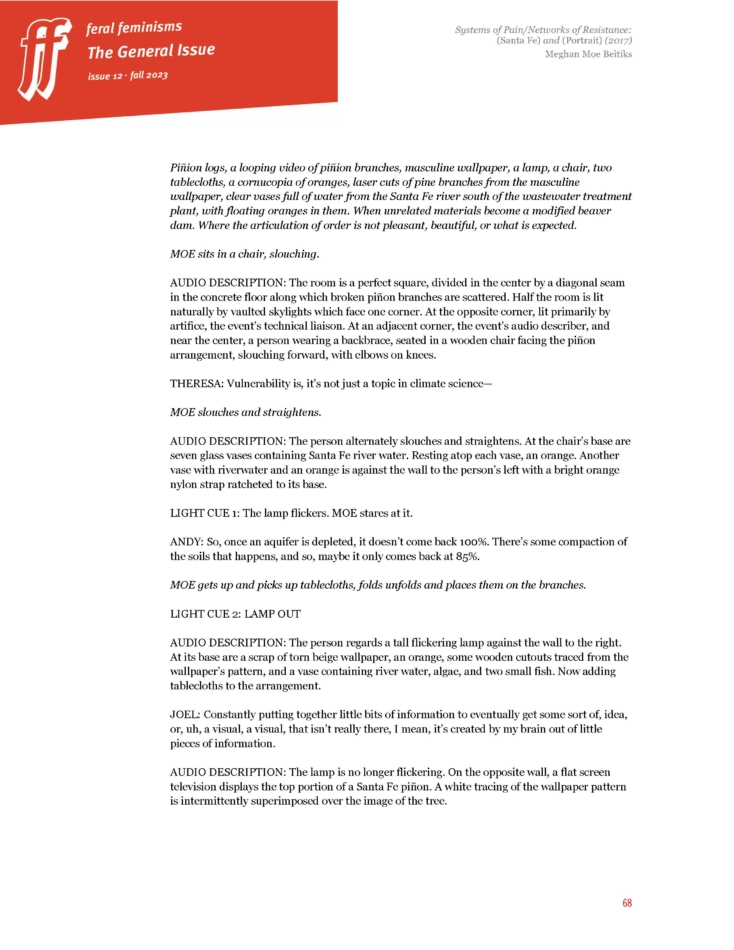






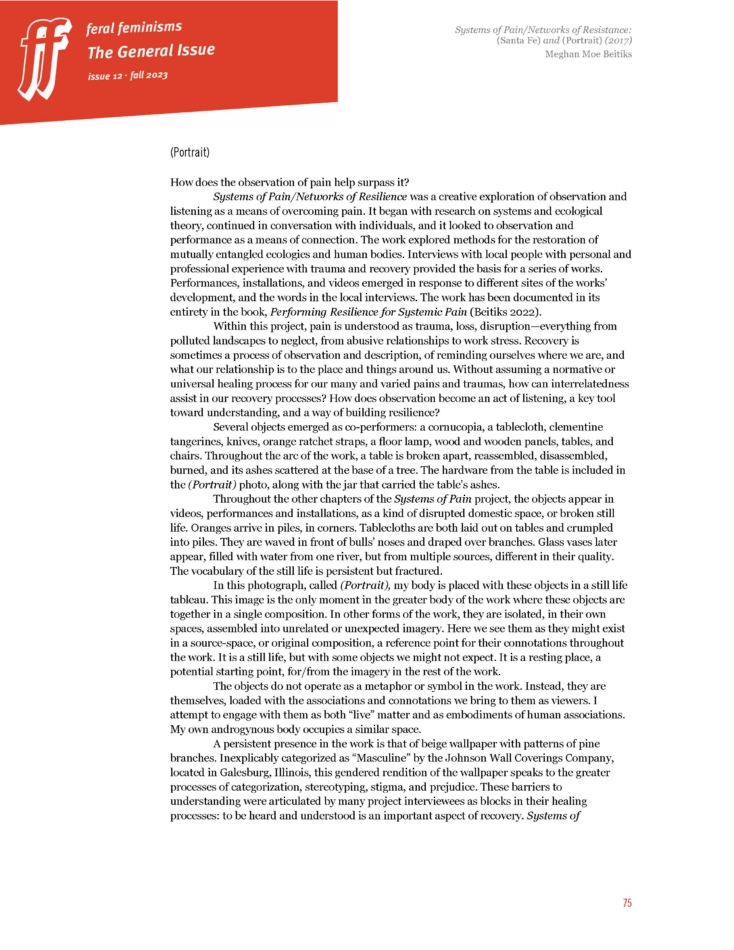


All Contested Phrases: An Aria (2022)
University of Florida faculty and community create conceptual aria from censored phrases
UPDATE: As of November 17th, 2022, federal judge has blocked the “Anti-Woke” Bill. Support the ACLU in continued efforts by buying aria merch on bonfire!
In response to efforts to impose censorship by the Provost at the University of Florida, a group of UF Faculty and community members have devised a creative performance using challenged language as the text for a contemporary aria. The aria, based in part on elements of compositions by the twentieth-century Russian composer Dmitri Shostakovich, draws ironic parallels between the actions of a staunchly “anti-socialist” state government and Stalinist legacies of censorship. It was performed April 15th, 2022 at Dad’s Bar in Gainesville, Florida, local to the university, as well as streamed online.
In anticipation of political initiatives of the state, the provost of the University of Florida asked university lawyers to review the College of the Arts’ Meta-Strategy. The Meta-Strategy was collaboratively written by college faculty to sharpen the college’s focus, planning, efforts, and funding over the next five years. It included the following phrases:
- unsettle
- deeply inequitable access to power
- systemic change
- correcting exclusionary and repressive systems
- undo systemic oppression and marginalization
- dismantle obstacles to AEI ingrained in our curriculum
- truth, and reconciliation
- negotiations of power and privilege as defined by organizational structures in the College of the Arts
- power analysis
- racial equity spheres to identify and document institutional practices that are barriers to a thriving pluralistic multicultural diversity
- micro-aggression
- Examine and reposition Western, white, male privilege implicit in the foundations of the style, techniques, and methodologies of historical works and traditional performance and practice. Address cultural differences within the disciplines represented in COTA
- eliminating discrimination and other forms of oppression
- AEI criteria at the ULO level
- provocative participation
- power and privilege
- negotiations of power and privilege
- barriers to a thriving pluralistic multicultural diversity
- prepare to or continue to engage race and racism curricularly
College faculty were asked by the provost to “reconsider” these terms. In this context, that consisted of a request to rewrite–academic censorship. In response, the faculty voted to convene a committee to review the document.
As a reaction to this pressure, a partially anonymous group of UF Faculty and community members gathered to turn the phrases “of concern” into their own melodic, conceptual performance, giving these words space to breathe on their own terms.
The music, composed by Florida musician Stephen Germana, combines elements of Shostakovich and Mahler in looping, electronic rhythms. The phrases of concern are sung by Brooklyn-based vocalist Kayleigh Butcher.
The performance includes projections and spoken word by Florida native artist Kenya (Robinson), production, and scholarly context by anonymous community members, and a movement-based response from dancer and UF faculty member Trent Williams.
A live performance of the Aria took place on April 15th at 8pm at Dad’s Bar, a local Gainesville venue supportive of community events: it was also livestreamed on Twitch.tv, Facebook and Instagram.
For inquiries, contact: Meghan Moe Beitiks, mobeitiks (at) gmail.com
RESOURCES
- Watch recordings of the stream on:
- Audio Samples of composition:
- Buy merchandise of the score, benefiting the ACLU:
- Dad’s Bar: https://www.instagram.com/dadsbar/
- About the UF College of the Arts Meta-Strategy:
- Press Kit here.
About the Cast & Crew:
Composer Stephen Germana: https://www.stephengermana.com/aboutnews
Soloist Kayleigh Butcher: http://www.kayleighbutcher.com/
Dancer Trent Williams: https://arts.ufl.edu/directory/profile/39257
Spoken Word and Projection Design by Kenya (Robinson): https://www.privilegeasplastic.com/
Producer Meghan Moe Beitiks: www.meghanmoebeitiks.com
The support team includes several anonymous members of the UF faculty and community, who have chosen not to reveal their names in order to avoid political backlash from within Florida and UF.
More on recent legislation on education in Florida:
Though many of these bills target K-12 schools, university administrators made a concerted effort to impose them on higher education, in part due to fears of backlash from the state. As of November 17th, 2022, a federal judge has blocked the “Anti-Woke” bill from higher education, but much harmful legislation remains in place: buy merch to support the ACLU and its efforts.
- HB 233:
- “Don’t Say Gay” Bill, HB 1557:
- “Anti-Woke” Bill: HB 7:
Performing Resilience for Systemic Pain (2022)
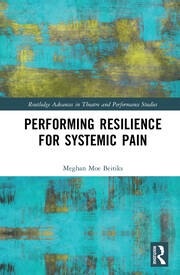
How might performance serve as a means for facing ubiquitous trauma and pain, in humans and ecologies?
While reflecting on my multidisciplinary work Systems of Pain/Networks of Resilience, I consider bodies of knowledge in Trauma Theory, Intersectional Feminist Philosophy, Ecology, Disability Studies, New Materialism, Object-Oriented Ontology, Gender Studies, Artistic Research, Psychology, Performance Studies, Social Justice, Performance Philosophy, Performance Art, and a series of first-person interviews in an attempt to answer that question. I write through the process of making the work and the real-life, embodied encounters with the theories explored within it as an expansion of the work itself. Facing down difficult issues like trauma, discrimination, and the vulnerability of the body, I looks to commonalities across species and disciplines as means of developing resilience and cultivating communities. Rather than paint a picture of glorious potential utopias, I takes a hard look at myself as an embodiment of the values explored in the work, and stays with the difficult, sucky, troubling, work to be done.
Performing Resilience for Systemic Pain is a vulnerable book about the quiet presence and hard looking needed to shift systems away from their oppressive, destructive realities.
Available now from Routledge. To request a review copy, fill out this form. Contact me for inquiries.
Dissatisfying Videos (2021)
Building on the ubiquitous “satisfying” videos on social media during this time, and incorporating distinctly uncomfortable realities, as articulated by important marginalized scholars. Featured in Performance is Alive, part of the Satellite Art Show of Art Basel Miami 2021.
Untitled (Desert Refractions) (2021)

Untitled (Desert Refractions)(2021) is a sculpture, installation and performance created in response to the reflective glass surfaces of many Las Vegas Resorts, the desert environment, the arc of the sun, and the poem Ozymandias. The work explores reflection, opulence, sunlight, legacy, and the impermanence of power. Devised with local performers, the piece included both pre-recorded and live-streamed light as the Las Vegas sun set in real-time.
Sound Structure: Stephen Germana
Sculpture: Meghan Moe Beitiks x Luis Varela-Rico
Rogers Art Loft: Lance Smith, Ryan Reid, Spencer Haley
Cameras: Shahab Zargari, Spencer Haley
Ozymandias
I met a traveller from an antique land,
Who said ‘Two vast and trunkless legs of stone
Stand in the desert. . . . Near them, on the sand,
Half sunk a shattered visage lies, whose frown,
And wrinkled lip, and sneer of cold command,
Tell that its sculptor well those passions read
Which yet survive, stamped on these lifeless things,
The hand that mocked them, and the heart that fed;
And on the pedestal, these words appear:
My name is Ozymandias, King of Kings;
Look on my Works, ye Mighty, and despair!
Nothing beside remains. Round the decay
Of that colossal Wreck, boundless and bare
The lone and level sands stretch far away.’

Untitled (Desert Refractions) sculpture, a collaboration with Luis Varela-Rico, permanently installed at Rogers Studio Gallery. Each of the gold panes of glass points towards a major resort with gold windows. Excerpts from the poem Ozymandias are sandblasted into the glass with industrial garnet and sand from the nearby Red Rock Canyon desert. Detailing with pyrite grit and fake gold spraypaint. The piece changes depending on the angle of the sun. Solar lights illuminate the sculpture at night.
























Untitled (Desert Refractions) long-term installation of gold/silver window film at the Rogers Studio Gallery. The windows of the Studio Gallery take on the reflective quality of opulent local resort windows.







Systems of Pain/Networks of Resilience (Nebraska) (interconnections) (2021)
Systems of Pain/Networks of Resilience (Nebraska) has been published in the first issue of interconnections: journal of posthumanism. After the peer-review process I was made the journal’s first Creative Works Editor.

A Lab for Apologies and Forgiveness / Candor Arts (2021)
A Lab for Apologies and Forgiveness is a collaborative publication with Candor Arts, one of the last publications from this important small-scale Chicago-based publisher, and a documentation of what was for me an epic project.
Available from the Live Art Development Agency unbound.
From the Candor Arts Website:
A Lab for Apologies and Forgiveness documents a multifaceted artwork inspired by the bacteria Geobacter sulfurreducens, which reduces radioactive uranium to a non-water-soluble isotope. When I first heard about the bacteria, it opened up an avenue of hope in me. It engages with, and limits, a substance that is otherwise toxic for 10,000 years, and prevents it from doing further harm. Over the works’ six different versions, I worked together with microbiologists, Episcopalian parishioners, several artists, a variety of materials, and the bacteria itself.
The Lab accumulated as a series of installations, performances, videos, written works, and feelings. This book is documentation of it in pictures and scripts, reflections on it from folks who witnessed it firsthand, and a raw look into its development and impact from the pages of my Lab book (initially a gift from the Franks Lab for Applied and Environmental Microbiology at LaTrobe University). I draw conclusions from my research, face down personal and scientific failures and reconciliations, open up questions for further experimentation.
Includes contributions from Dr. Ashley Franks, Sarah Knudtson, Laura Caroline de Lara, Tarsh Bates, Dr. Lucie Semenec, Dr. Jennifer Wood, Arjuna Capulong, Lauren Goldstein and Emerson Granillo.
Some things are not remediable. It’s okay.
Perfect Bound book with inkjet printed cover. Black toner printed pages on two papers.
Design: Melanie Teresa Bohrer
Production: Candor Arts
Supported with a Scholarship Enhancement Fund from the University of Florida.
ISBN: 978-1-950615-05-6
Points of Light (2021)
A livestreamed performance created for pandemic survival with Ray Oppenheimer for Out of Site and the Experimental Sound Studio, re-performed for the Reconnect Festival.
RBG/GDR/RGB (2020)
Recording of livestream performance, originally hosted by Online Performance Art
/Ruth Bader Ginsberg/Great Diurnal Range/Red Green Blue/
December 12th, 2020 was the 20th anniversary of Bush vs. Gore, when the Supreme Court was made to make a definitive decision on the outcome of the 2000 election. December 12th was also when Ruth Bader Ginsberg (RBG) made her famous “dissent”statement, writing from the minority position “I dissent” rather than the traditional “I respectfully dissent,” in protest of the outcome. RGB/GDR/RBG is a durational performance, a brutal engagement with time, and an opportunity to meditate on everything that has changed and been lost in 2020. On December 12th, artists Meghan Moe Beitiks and Ray Oppenheimer sat on opposite coastal states with significant electoral votes: Florida and California. Using the projection design program Isadora, the artists projected an image of Ginsberg’s “Dissent” collar on their own collarbones. The images of the collar changed in color (RGB) based on the date from their collaborator’s tides. In California, Ray’s collar changed according to Florida tides. In Florida, Moe’s collar changed according to California tides. The performance lasted 34 minutes, one minute for every additional electoral vote Biden received over Bush’s 271 electoral votes. The tidal data was drawn from predictions for levels between December 12th, 2020 and January 1st, 2021. The work also included audio and video from cultural ecologies at each site, images of election data and moments, and significant patterns from Ginsberg’s legacy. Beitiks and Oppenheimer enacted meditative spaces and gestures as a reflection on changing tides.
Great Diurnal Range is the difference, in tides, between the height of mean higher higher high water and mean lower low water. RGB is the standard color space for digital screens: Red, Green, Blue. They are also the primary colors of visible light, corresponding to Red, Green and Blue cones in the human eye. Ocean levels are rising. Political changes have profound ecological impacts. A lot has changed in 20 years, but the same fights keep resurfacing. RBG/GDR/RGB seeks to open up a space for reflection on interconnection, change, and political consequences. It seeks to honor the impactful legacy of a significant supreme court justice as a means both of reflecting on the ecological reality of cultural shifts, and meditating on hope for the future.
Ray Oppenheimer is a San Francisco Bay Area based lighting designer, educator, and creator who has been bringing his boundless curiosity, chimerical aesthetic, and sisyphean perseverance to live design and education since 2005. Ray graduated with a Master of Fine Arts in Theatre Arts with an emphasis in lighting design from San Francisco State University in the Fall of 2017. He also is an active company member with Mugwumpin and Shotgun Players.
Sound structure by Stephen Germana, an artist that primarily performs experimental music in an improvisational performance practice that balances between noise, drone, and free jazz. His artistic practice includes algorithmic sound/video, radio transmission, and lens based media. With degrees from School of the Art Institute of Chicago (MFA), University of Miami (MM), and University of Minnesota (BM), he teaches Fine Arts and Art History in South Florida, living in West Palm Beach with his partner Sarah Knudtson and their cats, Roland and Boonmee (Meep).
Performing Public Health (2020)
I am the Lead Facilitator of a project called Performing Pubic Health for the Center for Arts in Medicine, as part of their COVID-19 Arts Response.
From our website:
How do we collectively Perform Public Health? Three overlapping teams of artists, administrators, health officials, academics, researchers and activists offer tools for safe engagement with the arts, chronicle the adaptive powers of artists, and organize resources emerging from artist communities, in an attempt to answer that question.
The Advisory team has created a Performing Public Health Advisory Brief, which offers basic suggestions for safe practices, as well as appendices on infection control recommendations, finding reliable information and links to articles and studies for artists and communities effected by COVID-19.
The efforts include contributions to the COVID-19 Arts Response Repository, helping to chronicle the performance of public health through the arts during the time of the pandemic.
Within these efforts, Remote Cultures emerge in response to the lack of human contact that a pandemic imposes. In this context, Remote Cultures are the artworks, gatherings, adaptations and connections we create when health measures dictate social distance. They are how we maintain closeness, creativity, expression when the space between us is dictated by a virus or a law, or mediated by a screen or mask. Visit this page for a curated focus on the arts adaptive power in the context of a pandemic created by this team.
Within public health measures, the needs of marginalized artists are not always thoroughly considered. They are uniquely precarious, made vulnerable by systemic racism, disability, poverty, compromised immune systems, age, and a number of other factors. Marginalized artists can also possess experiential expertise directly relevant to a pandemic. The Unique Precarities team curates the work of vulnerable artists and communities and places them alongside institutional research, to serve as an interdisciplinary index of creative support. Please visit this page for resources from Uniquely Precarious artists and the systems in which they are entangled.
Performing Public Health considers the specialized concerns of artists and public gatherings at a time when gathering for in-person art experiences is constrained by the possible transmission of an infectious disease like COVID-19. Please visit the resources below for more information.

Graphic Design by Edith Williams.
Performing Public Health
This project was created by the following humans:
- Meghan Moe Beitiks, Artist, University of Florida
- Aaron Colverson, University of Florida
- Chloe Dean, University of Florida
- maxpaº hina minga (charlee huffman), MFA, M.Div. (Kansa/Potawatomi)
- Srinjoyi Lahiri, Young Artivist Alliance
- Keely Mason, University of Florida
- Edith Moore Hubert, Jacksonville University, Linda Berry Stein College of Fine Arts
- Virginia Pesata, University of Florida
- Katrina Pineda, California Representative of the Arts Health Early Career Research Network
- Natalie Rella, University of Florida
- Jill Sonke, University of Florida
- Marina Tsaplina, Transdisciplinary Artist, Health Humanities Scholar, Disability Advocate
- Edith Williams, Graphic Designer
- Kaitlyn Wittig Menguc, Artist & Arts Consultant
We’re also very grateful to our colleagues working in the arts, social work and activism, Arts + Health and Art Place America for their input on the development of this project.
Project Credits and Citations:
- Pesata, V., Moore Hubert, E., Wittig Menguc, K., Beitiks, MM. (2020). Performing Public Health: Advisory. Retrieved from (insert URL).
- Colverson, A., Pineda, K. Lahiri, S. (2020). Performing Public Health: Remote Cultures. Retrieved from (insert URL).
- Tsaplina, M., Beitiks, MM., Huffman, C. (2020). Performing Public Health: Unique Precarities. Retrieved from (insert URL).
Systems of Pain/Networks of Resilience (Moment 2) (World Futures) (2020)
Systems of Pain/Networks of Resilience (Moment 2) has been published in the peer-reviewed World Futures, in an issue on Queer Conviviality, edited by Sacha Kagan.
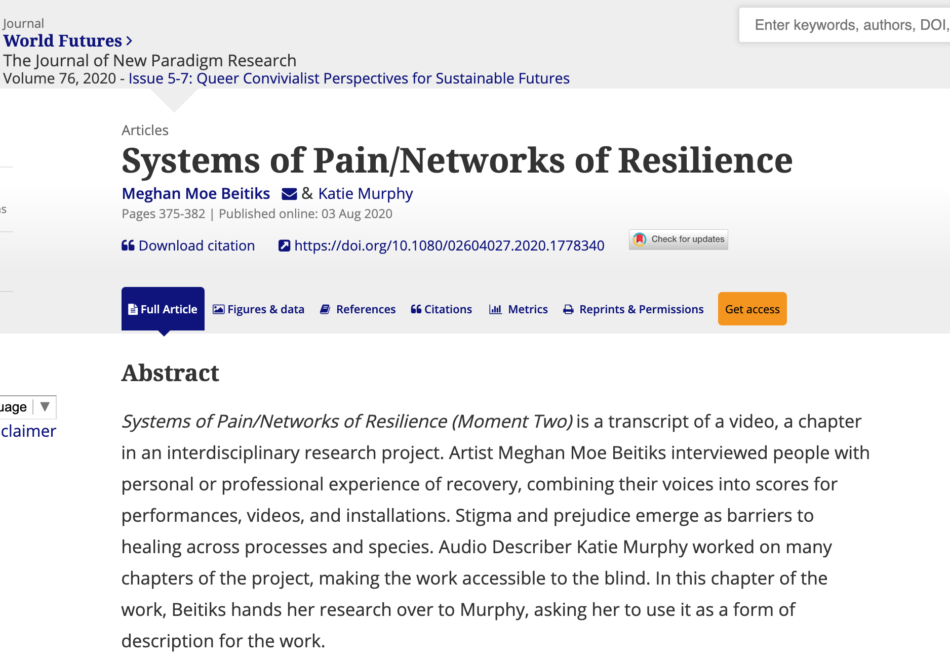
Black Lives>Artspeak (2020)
Two phrases, “Relationally Fundamental Aesthetics” and “Socially Literate Practice” are scrawled on the screens of two windows in chalk, distorted by reflections and layers. As day fades to night, the chalk becomes less visible, and light from indoors cuts through the lettering to read “Black Lives Matter.”
Please donate to GLITS (swopbehindbars.giv.sh/b9d2), the OKRA PROJECT (www.theokraproject.com/) or a local org that supports Black Trans, Queer & Femme Lives.
Featured in the 2020 Terrain Exhibitions Art in Place and Purple Window Gallery’s HELLO NEIGHBOR.
Requite (2019)
Created as a workshop performance during Indy Convergence 2019. Romantic comedy audio clips remixed into platonically queer acts of material care between humans and objects of theatricality and light. Full video here.
Tumbleweeds (2014/19)
Misperceptions, cartoonish gestures and desert landscapes. Featuring footage from “Bad Day at Black Rock.” Thanks to Marissa Lee Benedict and Lindsey French.
Untitled (Hinkley) (2014/18)
The re-performance of a single sigh from the 2000 movie “Erin Brockovich,” filmed around the real-life town of Hinkley, California, and infused with imagery and audio from the film. The artist reads text from a 2012 Environmental Impact Report detailing the aftermath from the pollution depicted in the film, and efforts to contain the toxic groundwater plume since the film’s release. With thanks to Marissa Lee Benedict, Lindsey French, Elise Cowin, Christine Shallenberg, and the Center for Land Use Interpretation Desert Research Station. Premieres at CUNTemporary’s Eco Futures Festival as part of DEEP TRASH: Eco Trash on April 19th, 2019.

Systems of Pain/Networks of Resilience (Exhibition) (2018)

Systems of Pain/Networks of Resilience (Exhibition) is a display of all of the chapters of the Systems of Pain/Networks of Resilience project in one gallery. Curated by Cecilia Vargas, on view at the Arrowhead Gallery in the Dickson Center at Waubonsee Community College, June 7-July 10th, 2018.
Photos courtesy of Waubonsee Community College.

Systems of Pain/Networks of Resilience (Moment 2) (2017)
A video following the material journey of a table through various sites from the Systems of Pain/Networks of Resilience project. Audio Describer Katie Murphy creates a soundtrack based on my research and interviews with project participants. Original table designed by Jason Friedes. An extended examination of observation and connection.
Systems of Pain/Networks of Resilience (Santa Fe) (2017)


A live performance, a chapter in Systems of Pain/Networks of Resilience. Interviews with Santa Fe locals about the diverted and hotly contested Santa Fe River. A performance with pinion logs, tablecloths, oranges, “Masculine” wallpaper, charcoal, and water from two points along the river. Plus two volunteer fishes. Audio description by Adam Harvey. Technical support by Alberto Romero. Thanks to the Santa Fe Art Institute. Photos by Jane Phillips.
Systems of Pain/Networks of Resilience (New York 2) (2017)
An interactive video chapter of the Systems of Pain/Networks of Resilience project, developed at the Wassaic Project and realized in full in the projects’ exhibition at the Dickson Center. Panels of “Masculine” wallpaper obscure the viewer’s experience of a video. Though they can hear an Audio Description of the work, as well as the voices of people from upstate New York, they can only view the video in its entirely by standing at a safe distance: not too close, not too far.





Flicker Fusion Threshold (2016)
 What is the rhythm of seeing breathing?
What is the rhythm of seeing breathing?
In order for humans to perceive singular images or bursts of light as continuous, it’s generally thought they should flicker at a rate of 50Hz. Critical flicker fusion rate.[1]
Early films determined that motion appeared continuous at rates of 16 frames per second, to push beyond the distraction of the shutter of a camera. Modern frame rates for digital media are set at 24-60 frames per second. But flicker rates and frame rates are not the same– humans can detect motion at much lower frame rates, and potentially detect flickers and interruptions at rates of 500 Hz.[2]
A lot depends on the intensity of a light or image, and there has been some debate as to exactly how the eye and brain combine moments of stillness into action.
The average resting adult human breathes 12-20 times per minute. Respiratory rate. [3]
In a hospital, nurses may calculate a patient’s breathing rate while measuring their pulse, not alerting the patient to the fact that their breaths are being observed: such awareness could alter the rhythm of their breathing.[4]
The observation of breath is central to many meditation practices. Practitioners of Anapanasanti, a method within Vipassana Meditation, will spend hour-long sessions focused soley on the sensation of their breathing, working to allow other feelings and thoughts to pass. Some studies have suggested that long-term meditation increases the number of gamma neural oscillations in practitioners.[5]
These oscillations are patterns of synchronized communication between neurons in the brain. Gamma waves are detectable in extracellular electric fields between 30-90 Hz. Gamma oscillations are thought to transiently link distributed cell assemblies that are processing related information, a function that is probably important for network processes such as perception, attentional selection and memory. Oscillations.[6]
One study has found that our neural oscillations determine our ability to perceive flashes of light.[7]
What passes in the flicker of a light?
A performance of breath with an EEG headset, and flickering images of animals and Trump supporters breathing. Performed at the Museum of Contemporary Art Chicago as part of MCA Live: aper_ture: admitting the light. Thanks to Ann Meisinger. Photos by Ji Yang. Thanks to Marissa Lee Benedict, Liz Ensz and Lindsey French for an intense few years of personal and artistic growth.
Flicker Fusion Threshold from Meghan Moe Beitiks on Vimeo.
[1] Davis, J. et al, “Humans Perceive flicker artifacts at 500 Hz,†Scientific Reports 5, Article number: 7861 (2015)
[2] Davis, J. et al, “Humans Perceive flicker artifacts at 500 Hz,†Scientific Reports 5, Article number: 7861 (2015)
[3] The Cleveland Clinic, http://my.clevelandclinic.org/health/diagnostics/hic_Vital_Signs, accessed July 31st, 2016
[4] Mooney, Gail P. “Respiratory assessment,†Nursing times, August 13th, 2007, http://www.nursingtimes.net/clinical-archive/respiratory/respiratory-assessment/200191.fullarticle, accessed July 31st, 2016
[5] Lutz, A. et al, “Long-term meditators self-induce high-amplitude
gamma synchrony during mental practice,†PNAS _ November 16, 2004 _ vol. 101 _ no. 46 _ 16373
[6] Colgin, LL. Et al, “Frequency of gamma oscillations routes flow of information in the hippocampus.†2009 Nov 19;462(7271):353-7.
[7] Busch et. Al, “The Phase of Ongoing EEG Oscillations predicts Visual Perception,†The Journal of Neuroscience, June 17, 2009 • 29(24):7869 –7876
Systems of Pain/Networks of Resilience (Installation One) (2016)
As part of the Studios Midwest Residency in Galesburg, Illinois, I created Systems of Pain/Networks of Resilience (Installation One) at Knox College’s Gallery The Box.
The piece featured documentation from SOP/NOR (Nebraska) on display in digital frames, as well as quotes from interviews for the piece in picture frames. The ashes of the broken/reassembled table from (Nebraska) were present, in a spilled jar, and the hardware from that table was used to secure the various cables in the installation. Various other props and artifacts from the (Nebraska) performance were also included.
The Box shares its space with Johnson Wallcovering Company, which features a “Masculine Wallpaper” section. Among the log cabin and sailboat patterns was a “Pine Trail” Wallpaper of no particular visual stereotype or gendered connotation. I include this wallpaper in the installation as a way of questioning the gender assignment of this particular depiction of nature.
Systems of Pain/Networks of Resilience is an exploration of observation as a tool for recovery from imbalance and trauma in human and non-human processes. I interview people with personal and professional experience with processes of recovery, then draw upon those interviews to create performance scores, videos and installations.
Systems of Pain/Networks of Resilience (Compilation: Words and Fields) (2016)
Presented at RIXC Open Fields Conference in Riga, Latvia, 2016.


